
1510
.pdf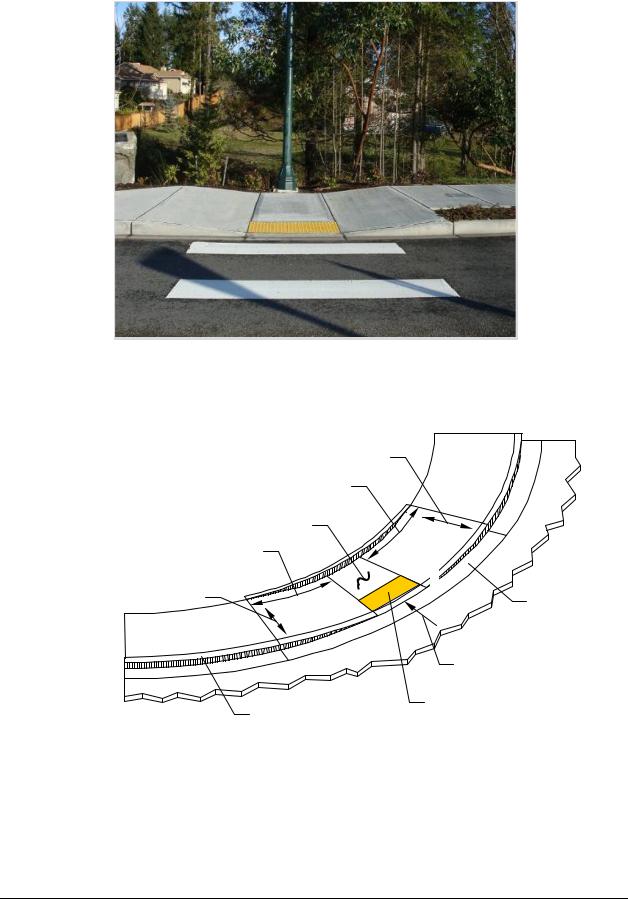
Chapter 1510 |
Pedestrian Facilities |
|
|
Parallel Curb Ramp
Exhibit 1510-10
Parallel Curb Ramp Common Elements
Exhibit 1510-11
WSDOT Design Manual M 22.01.08 |
Page 1510-21 |
July 2011 |
|
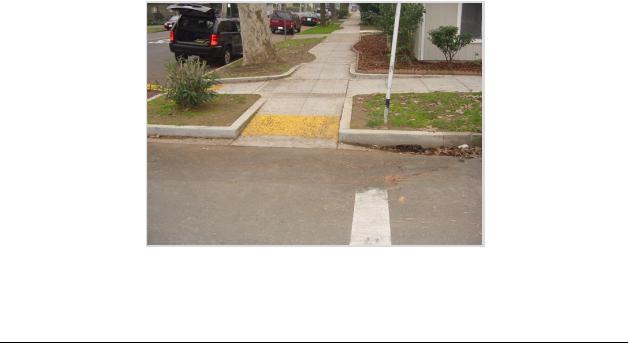
Pedestrian Facilities |
Chapter 1510 |
|
|
(c)Combination Curb Ramp
Combination curb ramps (see Exhibit 1510-12) combine the use of perpendicular and parallel types of curb ramps. Landings may be shared by multiple ramps in this application. Buffer areas and pedestrian curbing that define the pedestrian path of travel are inherent design elements for this type of curb ramp.
1.Advantages
•Allows the elevation difference between the sidewalk and the gutter line to be transitioned with multiple ramps. This can help achieve compliant ramp running slopes.
•Provides additional locations in the gutter line along the radius where drainage structures can be placed outside the pedestrian access route due to the well-defined pedestrian paths of travel.
•Can be constructed within available right of way when the right of way boundary is located at the back of the existing sidewalk, provided sufficient buffer width is available on the roadway side of the sidewalk.
•Provides a way to avoid the relocation of existing features such as utility poles, fire hydrants, and signal poles by incorporating those features into the buffer areas.
•The pedestrian curbing that defines the buffer areas and forms the curb returns for the perpendicular ramp connections facilitates direction finding for a vision-impaired person who navigates with a cane.
2.Disadvantages
•Has a higher construction cost than other curb ramp types due to extensive use of curbing and a larger footprint.
•Due to generally flatter ramp grades and multi-tiered ramp elements, inadequate drainage and accumulation of debris can occur.
Combination Curb Ramp
Exhibit 1510-12
Page 1510-22 |
WSDOT Design Manual M 22-01.08 |
|
July 2011 |

Chapter 1510 |
Pedestrian Facilities |
|
|
(2)Accessibility Criteria for Curb Ramps
The accessibility criteria for pedestrian circulation paths and pedestrian access routes (see 1510.06 and 1510.07) also apply to curb ramps unless superseded by the following accessibility criteria specifically for curb ramps:
(a)Clear Width
The clear width of curb ramps and their landings shall be 4 feet minimum, excluding flares.
(b)Running Slope
The running slope shall be 8.3% maximum.
Note: It is recommended that running slopes be designed to be less than the allowed maximum to allow for some tolerance in construction. For example, design for a maximum 7.5% curb ramp running slope (rather than 8.3% maximum).
The running slope of a perpendicular curb ramp shall intersect the gutter grade break at a right angle at the back of curb.
The curb ramp maximum running slope shall not require the ramp length to exceed 15 feet.
(c)Cross Slope
Not greater than 2%, measured perpendicular to the direction of travel.
Note: It is recommended that cross slopes be designed to be less than the allowed maximum to allow for some tolerance in construction. For example, design for
a maximum 1.5% cross slope (rather than 2% maximum).
Exception: The cross slopes of curb ramps at midblock crossings are permitted to match the street or highway grade.
(d)Landing
A level landing is required either at the top of a perpendicular ramp or the bottom of a parallel curb ramp, as noted in 1510.09(1)(a) and (b) for the type of curb ramp used.
Provide a landing that is at least 4 feet minimum length by 4 feet minimum width.
The running and cross slopes of a curb ramp landing shall be 2% maximum.
Note: It is recommended that cross slopes be designed to be less than the allowed maximum to allow for some tolerance in construction. For example, design for
a maximum 1.5% cross slope (rather than 2% maximum).
Exception: The running and cross slopes of landings for curb ramps at midblock crossings are permitted to match the street or highway grade.
WSDOT Design Manual M 22.01.08 |
Page 1510-23 |
July 2011 |
|

Pedestrian Facilities |
Chapter 1510 |
|
|
(e)Flares
Flared sides are to be used only where a pedestrian circulation path crosses the curb ramp from the side.
Flared sides are to have a slope of 10% maximum, measured parallel to the back of curb.
(f)Counter Slope
The counter slope of the gutter or street at the foot of a curb ramp or landing shall be 5% maximum.
(g)Detectable Warning Surfaces
Required where curb ramps or landings connect to a roadway. (See the Standard Plans for placement details and other applications.)
Detectable warning surfaces shall contrast visually (either light-on-dark or dark- on-light) with the adjacent walkway surface, gutter, street or highway.
Note: Federal yellow is the color used to achieve visual contrast on WSDOT projects. Within cities other contrasting colors may be used if requested by the city.
(h)Surfaces
Surfaces shall be firm, stable, and slip resistant.
Gratings, access covers, utility objects, and other appurtenances shall not be located on curb ramps, landings, or gutters within the pedestrian access route.
(i)Grade Breaks
Vertical alignment shall be planar within curb ramp runs, landings, and gutter areas within the pedestrian access route.
Grade breaks at the top and bottom of curb ramps shall be perpendicular to the direction of travel on the ramp run.
Surface slopes that meet at grade breaks shall be flush.
(j)Clear Space
Beyond the curb face where the bottom of a curb ramp or landing meets the gutter, a clear space of 4 feet minimum by 4 feet minimum shall be provided in the roadway that is contained within the width of the crosswalk and located wholly outside the parallel vehicle travel lane.
Note: Clear space is easily achieved when a separate curb ramp oriented in each direction of pedestrian travel within the width of the crosswalk it serves is provided.
(3)Curb Ramp Drainage
Surface water runoff from the roadway can flood the lower end of a curb ramp. Provide catch basins or inlets to prevent ponding at the base of curb ramps and landings. Exhibit 1510-13 shows examples of drainage structure locations. Verify that drainage structures will not be located in the pedestrian access route.
Page 1510-24 |
WSDOT Design Manual M 22-01.08 |
|
July 2011 |
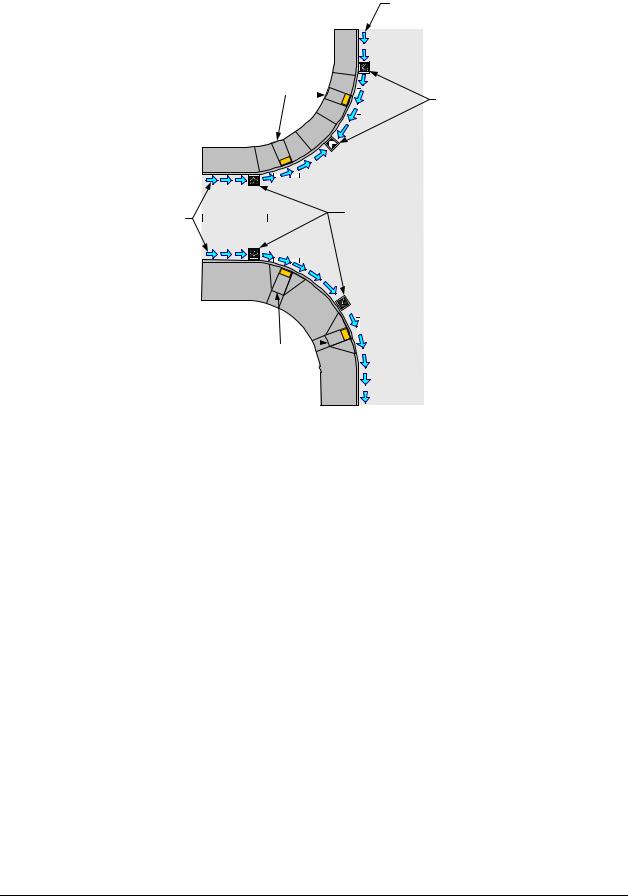
Chapter 1510 |
|
|
|
|
|
|
|
|
Pedestrian Facilities |
||||||||||||||||
|
|
|
|
|
|
|
|
|
|
|
|
|
|
|
|
|
|
|
|
|
|
|
|
|
|
|
|
|
|
|
|
|
|
|
|
|
|
|
|
|
|
|
|
|
|
|
|
|
|
|
|
|
|
|
|
|
|
|
|
|
|
|
|
|
|
|
|
|
|
|
|
|
|
|
|
|
|
|
|
|
|
|
|
|
|
|
|
|
|
|
|
|
|
|
|
|
|
|
|
|
|
|
|
|
|
|
|
|
|
|
|
|
|
|
|
|
|
|
|
|
|
|
|
|
|
|
|
|
|
|
|
|
|
|
|
|
|
|
|
|
|
|
|
|
|
|
|
|
|
|
|
|
|
|
|
|
|
|
|
|
|
|
|
|
|
|
|
|
|
|
|
|
|
|
|
|
|
|
|
|
|
|
|
|
|
|
|
|
|
|
|
|
|
|
|
|
|
|
|
|
|
|
|
|
|
|
|
|
|
|
|
|
|
|
|
|
|
|
|
|
|
|
|
|
|
|
|
|
|
|
|
|
|
|
|
|
|
|
|
|
|
|
|
|
|
|
|
|
|
|
|
|
|
|
|
|
|
|
|
|
|
|
|
|
|
|
|
|
|
|
|
|
|
|
|
|
|
|
|
|
|
|
|
|
|
|
|
|
|
|
|
|
|
|
|
|
|
|
|
|
|
|
|
|
|
|
|
|
|
|
|
|
|
|
|
|
|
|
|
|
|
|
|
|
|
|
|
|
|
|
|
|
|
|
|
|
|
|
|
|
|
|
|
|
|
|
|
|
|
|
|
|
|
|
|
|
|
|
|
|
|
|
|
|
|
|
|
|
|
|
|
|
|
|
|
|
|
|
|
|
|
|
|
|
|
|
|
|
|
|
|
|
|
|
|
|
|
|
|
|
|
|
|
|
|
|
|
|
|
|
|
|
|
|
|
|
|
|
|
|
|
|
|
|
|
|
|
|
|
|
|
|
|
|
|
|
|
|
|
|
|
|
|
|
|
|
|
|
|
|
|
|
|
|
|
|
|
|
|
|
|
|
|
|
|
|
|
|
|
|
|
|
|
|
|
|
|
|
|
|
|
|
|
|
|
|
|
|
|
|
|
|
|
|
|
|
|
|
|
|
|
|
|
|
|
|
|
|
|
|
|
|
|
|
|
|
|
|
|
|
|
|
|
|
|
|
|
|
|
|
|
|
|
|
|
|
|
|
|
|
|
|
|
|
|
|
|
|
|
|
|
|
|
|
|
|
|
|
|
|
|
|
|
|
|
|
|
|
|
|
|
|
|
|
|
|
|
|
|
|
|
|
|
|
|
|
|
|
|
|
|
|
|
|
|
|
|
Typical Curb Ramp Drainage
Exhibit 1510-13
1510.10 Crosswalks
(1) Design Considerations for Crossing Facilities
Designing intersections for the needs of all users, including pedestrians, involves various considerations and tradeoffs. The following list presents design considerations for crossing facilities that meet pedestrians’ needs:
Minimize turning radii to keep speeds low. (See Chapter 1310 for design vehicle guidance.)
Place crosswalks so they are visible and connect to the adjacent pedestrian facilities.
Provide sight distance (driver to pedestrian; pedestrian to driver).
Use a separate left-turn phase along with a “WALK/DON’T WALK” signal.
Restrict or prohibit turns.
Shorten crossing distance.
Use a raised median/cut-through island for a pedestrian refuge.
Use accessible pedestrian signals (APS).
Use signing and delineation as determined by the region Traffic Engineer.
Place crosswalks as close as practicable to the intersection traveled way.
Provide pedestrian-level lighting.
Consider the crosswalk location in relation to transit stops.
All pedestrian crossings need to provide a PAR that meets the accessibility criteria.
WSDOT Design Manual M 22.01.08 |
Page 1510-25 |
July 2011 |
|
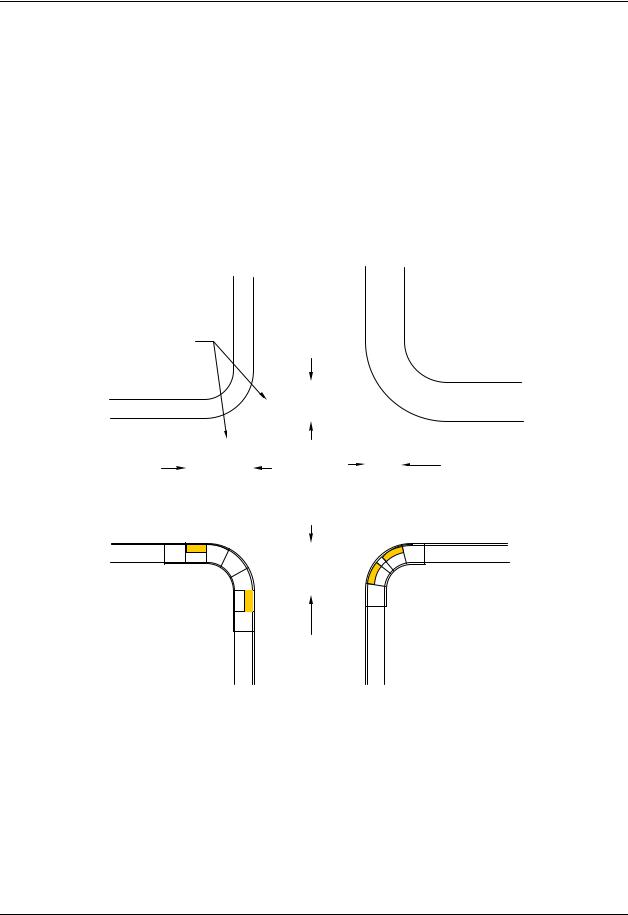
Pedestrian Facilities |
Chapter 1510 |
(2)Crosswalks at Intersections
Provide a pedestrian access route within marked and unmarked pedestrian crossings. (See 1510.07 for accessibility criteria for pedestrian access routes.) Exhibit 1510-28 provides recommendations for determining pedestrian markings based on lane configuration, vehicular traffic volume, and speed. However, the region Traffic Engineer makes the final determination on appropriate signing and delineation.
(a)Unmarked Crossings
Legal crosswalks exist at all intersections, whether marked or not. An unmarked crosswalk (see Exhibit 1510-14) is the portion of the roadway behind a prolongation of the curb or edge of the through traffic lane and a prolongation of the farthest sidewalk connection or, in the event there are no sidewalks, between the edge of the through traffic lane and a line 10 feet from there (RCW 46.04.160).
Unmarked Crosswalks
Exhibit 1510-14
(b)Marked Crossings
Marked crosswalks are used at intersections or midblock crossings. They are not to be used indiscriminately. Maintenance agreements and RCW 47.24.020(30) provide jurisdictional authority for decisions to mark crosswalks based on a population threshold of 25,000 and should be consulted prior to a decision to mark crosswalk. Consult region Traffic Offices for “best practices” for marking crosswalks based on intersection type.
Page 1510-26 |
WSDOT Design Manual M 22-01.08 |
|
July 2011 |
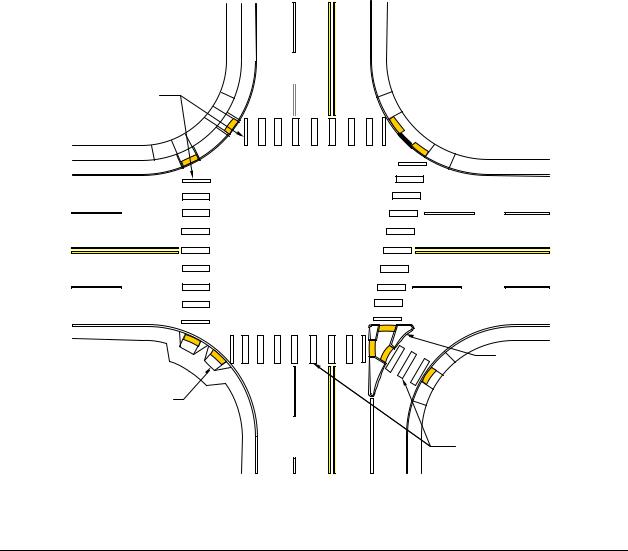
Chapter 1510 |
Pedestrian Facilities |
|
|
The MUTCD is a good resource to use when evaluating locations for marking consideration.
Note: The installation of a midblock pedestrian crossing on a state highway is a design deviation that requires documentation and ASDE approval.
The desirable width for a marked crosswalk is 10 feet (6 feet minimum with justification). The preferred type of marked crosswalk is a longitudinal pattern known as a Ladder Bar, which is shown in the Standard Plans and Exhibit 1510-15. Stop and yield line dimensions and placement must conform to the MUTCD and are shown in the Standard Plans.
Communities sometimes request specially textured crosswalks (such as colored pavement, bricks, or other materials). Some textured materials may cause confusion for visually impaired pedestrians and can create discomfort for wheelchair users. These decorative crosswalks do not always fall within the legal definition of a marked crosswalk, and supplemental parallel white crosswalk lines are recommended to enhance visibility and delineate the crosswalk. For more information, see the MUTCD and the Local Agency Crosswalk Options website:
www.wsdot.wa.gov/design/standards/plansheet/pm-2.htm
Marked Pedestrian Crossing
Exhibit 1510-15
WSDOT Design Manual M 22.01.08 |
Page 1510-27 |
July 2011 |
|
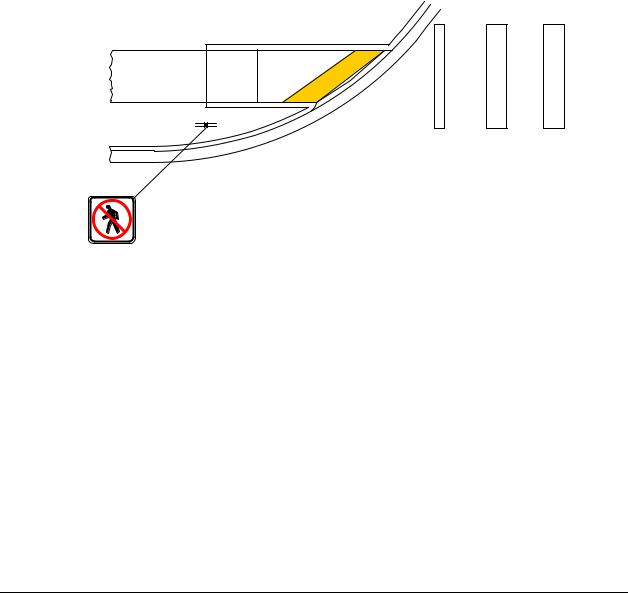
Pedestrian Facilities |
Chapter 1510 |
|
|
(c)Closed Crossings
Pedestrian crossings at grade are permitted along the length of most highways. Pedestrian crossing on all legs of an intersection is also permitted, whether a crosswalk is marked or unmarked. An illegal pedestrian crossing only occurs when signs prohibit a particular crossing at an intersection or the crossing occurs between two adjacent signalized intersections (RCW 46.61.240).
To meet ADA requirements at any given crossing, equal access to cross the highway shall be provided to all pedestrians unless the pedestrian crossing is prohibited to all pedestrians. Consult with the region Traffic Office when considering a prohibited crossing. Also:
Provide an accessible alternative to the closed crossing.
Make each side of the closed crossing inaccessible to all pedestrians.
Install signs and a treatment that is detectable by vision-impaired persons who navigate with a cane, restricting all pedestrians from crossing at that location. An example of a closed pedestrian crossing is shown in Exhibit 1510-16.
Note: See the Standard Plans for additional details.
Example of Closed Pedestrian Crossing
Exhibit 1510-16
(3)Midblock Crosswalks
On roadways with pedestrian crossing traffic caused by nearby pedestrian generators,
a midblock crossing may be an appropriate design. (See 1510.10(2) for crosswalk criteria and Exhibit 1510-28 for marked crosswalk recommendations at unsignalized intersections.)
Conditions that might favor a midblock crossing include the following:
Significant pedestrian crossing demand.
Pedestrians fail to recognize the best or safest place to cross along a highway and it is advisable to delineate the optimal location.
The adjacent land use creates high concentrations of pedestrians needing to cross the highway at that location.
Page 1510-28 |
WSDOT Design Manual M 22-01.08 |
|
July 2011 |
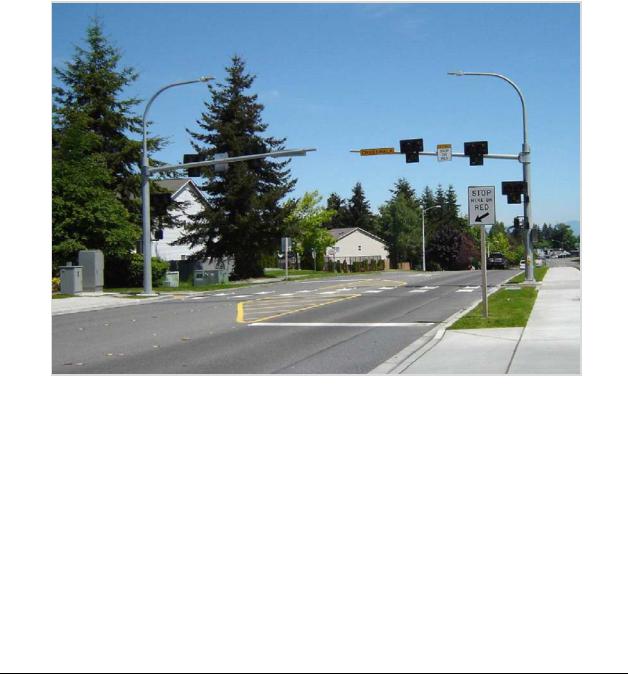
Chapter 1510 |
Pedestrian Facilities |
|
|
The proposed crossing can concentrate or channel multiple pedestrian crossings to a single location.
The crossing is at an approved school crossing on a school walk route.
There is adequate sight distance for motorists and pedestrians.
It is farther than 300 feet from an existing intersection.
Speeds are less than 40 mph.
To meet the accessibility criteria, the pedestrian access route in the crosswalk at
a midblock crossing may have a cross slope that matches the grade of the roadway. Note that the installation of a midblock pedestrian crossing on a state highway is a design deviation that requires ASDE approval and documentation. An example of a midblock crossing is shown in Exhibit 1510-17.
Midblock Pedestrian Crossing
Exhibit 1510-17
(4)Sight Distance at Crosswalks
When locating crosswalks at intersections, it is important to evaluate the sight lines between pedestrians and motorists. Shrubbery, signs, parked cars, and other roadside elements can block motorists’ and pedestrians’ views of one another. Exhibit 1510-18 illustrates these sight distance concerns.
WSDOT Design Manual M 22.01.08 |
Page 1510-29 |
July 2011 |
|
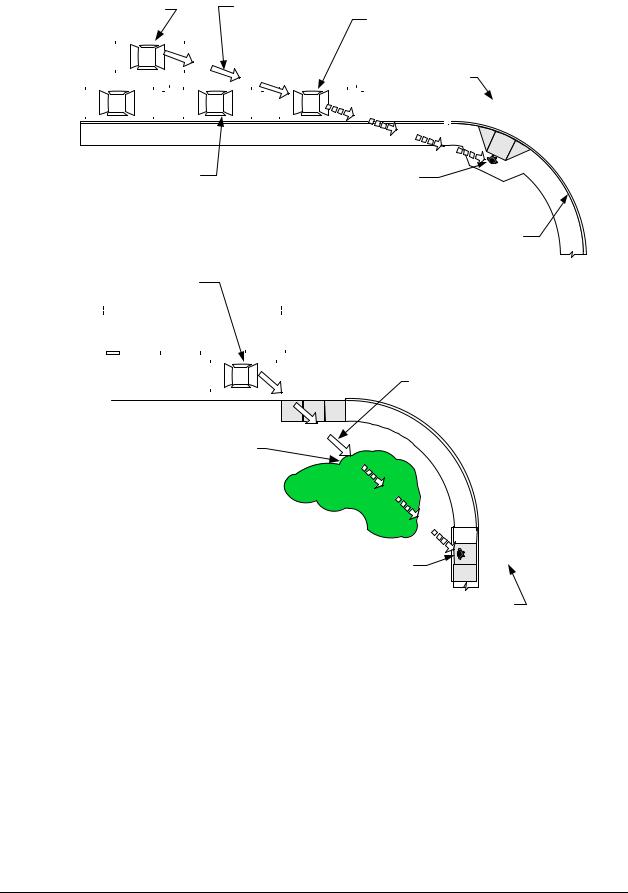
Pedestrian Facilities |
|
|
|
|
Chapter 1510 |
||||||||||||||||||||||||||||||||||||||||
|
|
|
|
|
|
|
|
|
|
|
|
|
|
|
|
|
|
|
|
|
|
|
|
|
|
|
|
|
|
|
|
|
|
|
|
|
|
|
|
|
|
|
|
|
|
|
|
|
|
|
|
|
|
|
|
|
|
|
|
|
|
|
|
|
|
|
|
|
|
|
|
|
|
|
|
|
|
|
|
|
|
|
|
|
|
|
|
|
|
|
|
|
|
|
|
|
|
|
|
|
|
|
|
|
|
|
|
|
|
|
|
|
|
|
|
|
|
|
|
|
|
|
|
|
|
|
|
|
|
|
|
|
|
|
|
|
|
|
|
|
|
|
|
|
|
|
|
|
|
|
|
|
|
|
|
|
|
|
|
|
|
|
|
|
|
|
|
|
|
|
|
|
|
|
|
|
|
|
|
|
|
|
|
|
|
|
|
|
|
|
|
|
|
|
|
|
|
|
|
|
|
|
|
|
|
|
|
|
|
|
|
|
|
|
|
|
|
|
|
|
|
|
|
|
|
|
|
|
|
|
|
|
|
|
|
|
|
|
|
|
|
|
|
|
|
|
|
|
|
|
|
|
|
|
|
|
|
|
|
|
|
|
|
|
|
|
|
|
|
|
|
|
|
|
|
|
|
|
|
|
|
|
|
|
|
|
|
|
|
|
|
|
|
|
|
|
|
|
|
|
|
|
|
|
|
|
|
|
|
|
|
|
|
|
|
|
|
|
|
|
|
|
|
|
|
|
|
|
|
|
|
|
|
|
|
|
|
|
|
|
|
|
|
|
|
|
|
|
|
|
|
|
|
|
|
|
|
|
|
|
|
|
|
|
|
|
|
|
|
|
|
|
|
|
|
|
|
|
|
|
|
|
|
|
|
|
|
|
|
|
|
|
|
|
|
|
|
|
|
|
|
|
|
|
|
|
|
|
|
|
|
|
|
|
|
|
|
|
|
|
|
|
|
|
|
|
|
|
|
|
|
|
|
|
|
|
|
|
|
|
|
|
|
|
|
|
|
|
|
|
|
|
|
|
|
|
|
|
|
|
|
|
|
|
|
|
|
|
|
|
|
|
|
|
|
|
|
|
|
|
|
|
|
|
|
|
|
|
|
|
|
|
|
|
|
|
|
|
|
|
|
|
|
|
|
|
|
|
|
|
|
|
|
|
|
|
|
|
|
|
|
|
|
|
|
|
|
|
|
|
|
|
|
|
|
|
|
|
|
|
|
|
|
|
|
|
|
|
|
|
|
|
|
|
|
|
|
|
|
|
|
|
|
|
|
|
|
|
|
|
|
|
|
|
|
|
|
|
|
|
|
|
|
|
|
|
|
|
|
|
|
|
|
|
|
|
|
|
|
|
|
|
|
|
|
|
|
|
|
|
|
|
|
|
|
|
|
|
|
|
|
|
|
|
|
|
|
|
|
|
|
|
|
|
|
|
|
|
|
|
|
|
|
|
|
|
|
|
|
|
|
|
|
|
|
|
|
|
|
|
|
|
|
|
|
|
|
|
|
|
|
|
|
|
|
|
|
|
|
|
|
|
|
|
|
|
|
|
|
|
|
|
|
|
|
|
|
|
|
|
|
|
|
|
|
|
|
|
|
|
|
|
|
|
|
|
|
|
|
|
|
|
|
|
|
|
|
|
|
|
|
|
|
|
|
|
|
|
|
|
|
|
|
|
|
|
|
|
|
|
|
|
|
|
|
|
|
|
|
|
|
|
|
|
|
|
|
|
|
|
|
|
|
|
|
|
|
|
|
|
|
|
|
|
|
|
|
|
|
|
|
|
|
|
|
|
|
|
|
|
|
|
|
|
|
|
|
|
|
|
|
|
|
|
|
|
|
|
|
|
|
|
|
|
|
|
|
|
|
|
|
|
|
|
|
|
|
|
|
|
|
|
|
|
|
|
|
|
|
|
|
|
|
|
|
|
|
|
|
|
|
|
|
|
|
|
|
|
|
|
|
|
|
|
|
|
|
|
|
|
|
|
|
|
|
|
|
|
|
|
|
|
|
|
|
|
|
|
|
|
|
|
|
|
|
|
|
|
|
|
|
|
|
|
|
|
|
|
|
|
|
|
|
|
|
|
|
|
|
|
|
|
|
|
|
|
|
|
|
|
|
|
|
|
|
|
|
|
|
|
|
|
|
|
|
|
|
|
|
|
|
|
|
|
|
|
|
|
|
|
|
|
|
|
|
|
|
|
|
|
|
|
|
|
|
|
|
|
|
|
|
|
|
|
|
|
|
|
|
|
|
|
|
|
|
|
|
|
|
|
|
|
|
|
|
|
|
|
|
|
|
|
|
|
|
|
|
|
|
|
|
|
|
|
|
|
|
|
|
|
|
|
|
|
|
|
|
|
|
|
|
|
|
|
|
|
|
|
|
|
|
|
|
|
|
|
|
|
|
|
|
|
|
|
|
|
|
|
|
|
|
|
|
|
|
|
|
|
|
|
|
|
|
|
|
|
|
|
|
|
|
|
|
|
|
|
|
|
|
|
|
|
|
|
|
|
|
|
|
|
|
|
|
|
|
|
|
|
|
|
|
|
|
|
|
|
|
|
|
|
|
|
|
|
|
|
|
|
|
|
|
|
|
|
|
|
|
|
|
|
|
|
|
|
|
|
|
|
|
|
|
|
|
|
|
|
|
|
|
|
|
|
|
|
|
|
|
|
|
|
|
|
|
|
|
|
|
|
|
|
|
|
|
|
|
|
|
|
|
|
|
|
|
|
|
|
|
|
|
|
|
|
|
|
|
|
|
|
|
|
|
|
|
|
|
|
|
|
|
|
|
|
|
|
|
|
|
|
|
|
|
|
|
|
|
|
|
|
|
|
|
|
|
|
|
|
|
|
|
|
|
|
|
|
|
|
|
|
|
|
|
|
|
|
|
|
|
|
|
|
|
|
|
|
|
|
|
|
|
|
|
|
|
|
|
|
|
|
|
|
|
|
|
|
|
|
|
|
|
|
|
|
|
|
|
|
|
|
|
|
|
|
|
|
|
|
|
|
|
|
|
|
|
|
|
|
|
|
|
|
|
|
|
|
|
|
|
|
|
|
|
|
|
|
|
|
|
|
|
|
|
|
|
|
|
|
|
|
|
|
|
|
|
|
|
|
|
|
|
|
|
|
|
|
|
|
|
|
|
|
|
|
|
|
|
|
|
|
|
|
|
|
|
|
|
|
|
|
|
|
|
|
|
|
|
|
|
|
|
|
|
|
|
|
|
|
|
|
|
|
|
|
|
|
|
|
|
|
|
|
|
|
|
|
|
|
|
|
|
|
|
|
|
|
|
|
|
|
|
|
|
|
|
|
|
|
|
|
|
|
|
|
|
|
|
|
|
|
|
|
|
|
|
|
|
|
|
|
|
|
|
|
|
|
|
|
|
|
|
|
|
|
|
|
|
|
|
|
|
|
|
|
|
|
|
|
|
|
|
|
|
|
|
|
|
|
|
|
|
|
|
|
|
|
|
|
|
|
|
|
|
|
|
|
|
|
|
|
|
|
|
|
|
Obstructed Line of Sight at Intersection
Exhibit 1510-18
(5)Curb Extensions
Curb extensions are traffic calming measures that may improve sight distance and reduce pedestrian crossing times, which limits pedestrian exposure. Installing a curb extension can help reduce the sight distance problem with parked cars that limit driver/pedestrian visibility. Curb extensions may allow for better curb ramp design as well as provide more space for pedestrians. Curb extensions are not an option on streets with high-speed traffic or without on-street parking because drivers would be confronted with sudden changes in roadway width.
Page 1510-30 |
WSDOT Design Manual M 22-01.08 |
|
July 2011 |
